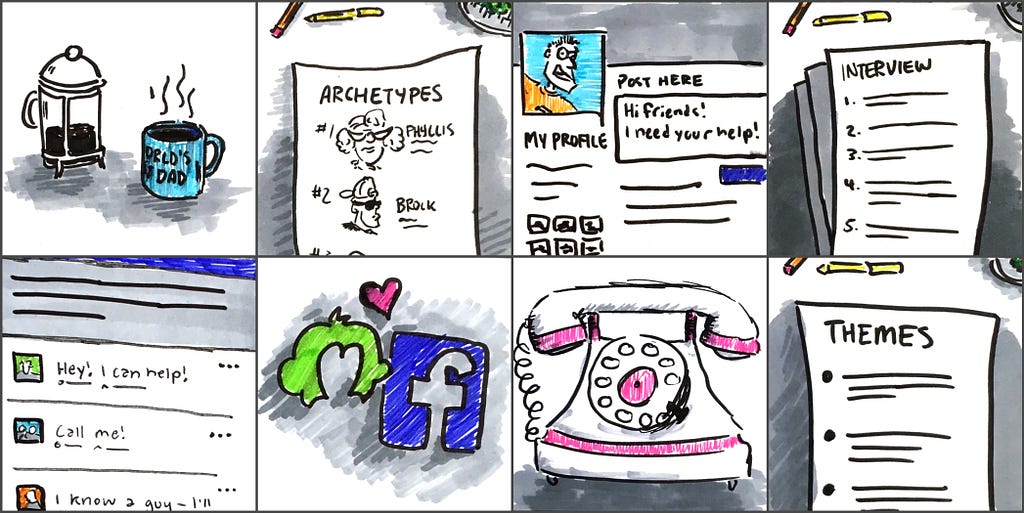Build Design Systems With Penpot Components
Penpot's new component system for building scalable design systems, emphasizing designer-developer collaboration.

uxdesign.cc – User Experience Design — Medium | Joe Salowitz
Ugh… Research? Stop beating the dead horse. My client won’t pay for it and I don’t have enough time to do it right. Besides, I feel like we have enough information to run on and start ideating some solutions. How much more insight will research really provide? I can probably just skip it and it’ll all be fine…

UXers often find themselves without budget or time to do research properly. I’ve been there too. But I’ve found that skipping it always yields a lackluster result.
So I developed a speed research technique that I’ve used often when I don’t have enough money or time to do proper UX research phase. I’m writing this to share it with you.
But first, we need to have a sit down talk about the bad habit we UXers have of skipping research.
As aligned as you might think you all are at the start of any project:
Here is the singular truth: every single time, insights found through research will blow up you and your client’s assumptions about the user, their world, and the creation you’re tasked with building.
No one has the same perspective, even when looking at the same thing.
 Remember the infamous dress debate? Blue & Black or White & Gold?
Remember the infamous dress debate? Blue & Black or White & Gold?
Throughout the years, I’ve consistently gotten surprising results every time I do a little research. Results that have saved me and my clients months of time and (not exaggerating) millions of dollars.
Here are some examples:
And most recently, just this year actually, research revealed to me that the iOS app we were building wasn’t the best way to serve our target users — but a much-cheaper to implement chat-bot was.
The value of research is obvious. It saves money. It saves time. It helps you build better products and solve the right problem.
Bonus: the value doesn’t stop with insights. As you take the raw research data and begin to synthesize and analyze it, you’ll start to build for yourself an arsenal of data-backed conclusions. As a practitioner, having sound reasoning to back the future design decisions you’re going to make is insanely valuable.
But how do we fit it into projects with no money or time for it?
Great news: I have technique that has allowed me to consistently do UX research while also saving time and money.
8:00 to 8:05 Grab a coffee
8:05 to 8:15 On a sheet of paper, list out your target user archetypes (what’s an archetype?) (e.g. 35–50 year old active women in Brooklyn).
8:15 to 8:30 Post a note on social media and send some texts asking for candidates in that demographic.
Hey friends! I’m doing some research and need to chat with [target demographic] for 10 minutes, anyone available?
8:30 to 9:30 While you’re waiting for responses, plan your approach.

9:30 to 9:45 Check back in on social media and your texts, some people have probably replied by now. Get in touch with those people and start arrange calls for as soon as possible: “Hi, can you chat for 10 minutes?”
9:45 to 9:50 Grab another coffee and a scone before your interviews begin. R&R is important.
9:50 to 10:00 Post your Survey Monkey interview on your Facebook (make sure to add demographic questions to Survey Monkey so you can weed out random people who decided to take the survey).
10:00 to 11:30 Call and interview people. Don’t take too long per call (5 to 10 minutes is enough). Between calls, jot down a few insights you learned from the calls. Read through any submitted Survey Monkey forms and record any insights from those as well.
11:30 to 12:00 Spend the last 30 minutes digesting the insights you gained from the interview. Right down a few overall trends and themes you noticed.

By the end of this blitz research process — you should have developed a good understanding of 3 things:
Share these with your client. Adjust project expectations or goals as needed.
Often times, gaining these insights right off of the bat will speed up the rest of your work. After a good research cycle, you will intimately understand and be able to empathize better with your client’s customers.
You’ll find that your ideation and the subsequent solutioning process will be more efficient.
You’ll save time in your client conversations, which will become much less “me-vs-you” argumentative and more “us-for-them” customer-focused and data driven.
The few hours you spent researching will be gained back quickly in efficiency and mitigated arguments, and you may will often find you finish your work sooner than you would’ve before.
When you respect the value of research, and you prioritize it in your process, you’ll find that your focus become clearer, and you end up solving the right problem quicker.
It’s okay to do speed research in place of a more extended research phase. It’s not okay to skip research entirely.
Doing research will result will be a happier end-user, because you’re solving real friction in their lives, a happier client, because your research uncovered the most effective solution for their business, and a happier you, because you are spending most of your time doing work that you believe in, that is defensible with data, that is making your clients happy, and that is making a real difference for the user.
And let’s be honest, you would have typically spent that research morning reading Medium articles anyways.
Speed UX research how to: No time? No money? No problem! was originally published in UX Design Collective on Medium, where people are continuing the conversation by highlighting and responding to this story.
AI-driven updates, curated by humans and hand-edited for the Prototypr community